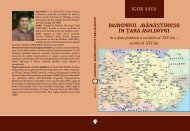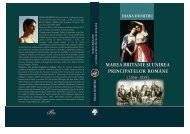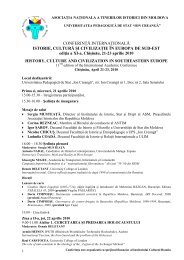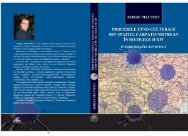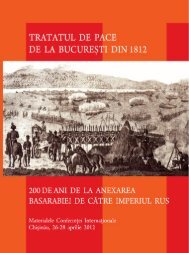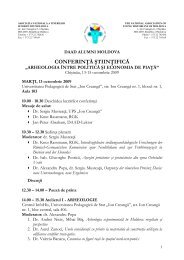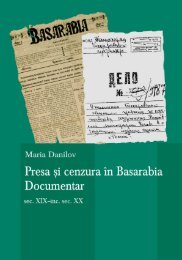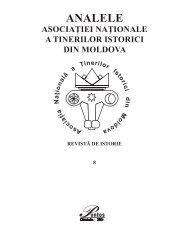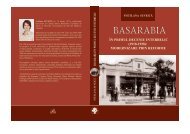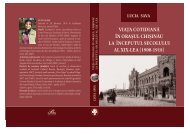Document PDF - Asociatia Tinerilor Istorici din Moldova
Document PDF - Asociatia Tinerilor Istorici din Moldova
Document PDF - Asociatia Tinerilor Istorici din Moldova
Sie wollen auch ein ePaper? Erhöhen Sie die Reichweite Ihrer Titel.
YUMPU macht aus Druck-PDFs automatisch weboptimierte ePaper, die Google liebt.
different individuals or institutions throughout the sixteenth century. He collected the information<br />
on this issue for different towns from secondary literature published in the fi rst half of the<br />
twentieth century and comes up with the following average yearly amount of money given to<br />
the students: 49 for Ingolstadt in 1494 – 20 fl orins, for Heidelberg in 1509 - 31 fl orins, for Memmingen<br />
in 1510 – 25 fl orins, for Ingolstadt in 1515 – 18 fl orins, for Pavia in 1519 – 50 fl orins, for<br />
Lindau in 1533 – 30 fl orins, for Groningen in 1555 – 20 fl orins and for Jena in 1557 – 30 florins.<br />
In Nürnberg, accor<strong>din</strong>g to Ebneth, students received from 25 to 50 fl orins yearly throughout<br />
the entire sixteenth century. The students from the town of Kitzingen in the second half of the<br />
sixteenth century benefi ted from a similar amount of money, from 20 to 45 fl orins annually.<br />
Ebneth considers that the amount of 50 fl orins per year was actually suffi cient to cover all<br />
basic costs of a single student in the second half of the sixteenth century, this amount being<br />
comparable with the yearly income of certain category of employees, as for example of an<br />
unmarried manual worker in Nürnberg who received approximately 35 fl orins per year in 1545<br />
and slightly more than 75 fl orins in 1622. 50 In the fi rst half of the seventeenth century, however,<br />
the prices and, together with this, the fi nancial needs of the students increased. Thus, for the<br />
middle of the seventeenth century, the average amount considered suffi cient for a student’s<br />
accommodation and food at the University of Altdorf, for example, constituted 75 fl orins per<br />
year, the maximum amount being 125 fl orins, accor<strong>din</strong>g to the archival documents quoted by<br />
Ebneth. 51<br />
As for Košice, there is no direct documentation for the standards the town council applied<br />
in determining the amount and duration of each proffered fi nancial support. The question<br />
about the amount of money granted to the students can be answered with the help of various<br />
notes spread throughout various documents related to educational matters. It appears that<br />
there was no explicit policy concerning the sum of money which was supposed to be given<br />
to the students and this amount varied from case to case. There are a few cases, however,<br />
suggesting that the average amount of fi nancial support given to students for the University<br />
of Wittenberg, for instance, was 50 fl orins per year. This was the case for Jacob Melczer, for<br />
example, who received a total of 200 fl orins for his studies, and he stayed at the University<br />
of Wittenberg for four years, from 1566 to 1570. The same amount – 50 fl orins – was given<br />
to Stephanus Mustricz and Stephanus Tehani, although, from the inscription in the town protocols<br />
it is unclear for what time period they received this amount, or if it was for one person<br />
or for both of them together. Again, the sum of 50 fl orins was requested and later received<br />
by Georgius Buntzler. At the top of a letter written by a certain Martinus Brechtel and sent to<br />
the town council in March 1590 there is an inscription which states: The honourable and wise<br />
council has decided unanimously to give for that purpose […] 50 fl orins for one year, 52 which<br />
confi rms again that the usual practice was to give 50 fl orins for one year of study at the University<br />
of Wittenberg. This is further demonstrated by Christophorus Ledwisch, another student<br />
from Košice, in his fi rst letter sent from Wittenberg in 1616, where he mentioned the 50 fl orins<br />
granted to him as a stipend for one year to study at the university and expressed his hope that<br />
he would receive this same amount in subsequent years as well. 53 This way, it is clear that students<br />
from Košice were fi nanced at the same level as their fellow students coming from other<br />
towns in German speaking territories, based on the data presented above.<br />
Other sums of money appear as well. Some of the students’ letters contain additional<br />
entries on their front page, written by a third person, most probably the town notary, who would<br />
record the decisions of the town council’s meeting where the respective letter was read and<br />
49<br />
EBNETH 1994, 213, with reference to the respective sources.<br />
50<br />
EBNETH 1994, 213-214.<br />
51<br />
EBNETH 1994, 215.<br />
52<br />
E.N.W. Rath hat eintrechtig beschlossen und derwilligen […] strecken 50 fl . auf ein Jarr.<br />
53<br />
AMK H I, no. 5782/8.<br />
– 213 –



